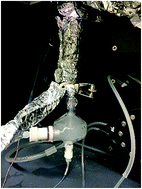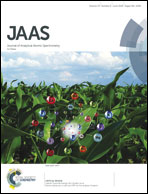Improvements to the analytical performance of inductively coupled plasma optical emission spectrometry by coupling a multi-mode sample introduction system to an infrared heated pre-evaporation tube†‡
Abstract
A multimode sample introduction system (MSIS) was coupled to a pre-evaporation tube, which was connected to the base of the torch in inductively coupled plasma optical emission spectrometry (ICPOES). The pre-evaporation tube and bottom 7 cm (for ARCOS instrument) or 3 cm (for Agilent instrument) of the torch were surrounded by an infrared-heated ceramic rope, which was heated to 80 °C in nebulisation mode and to 100 °C or 175 °C in hydride generation and dual modes. This resulted in improved sensitivity and detection limit for many elements, especially hydride-forming ones, compared to what is achieved with pneumatic nebulisation, but in some degradation of precision. The applicability of the approach was demonstrated through the accurate determination of several elements in two standard reference materials (waste water and corn bran) with matrix matching but without internal standardization. With infrared heating and operating MSIS in hydride generation (HG) mode, more elements than expected could be accurately determined, including Be, Co, Cr, Mg, Mn, etc., whose determination had not been reported in this mode before.

- This article is part of the themed collection: 2018 Winter Conference of Plasma Spectrochemistry, Amelia Island, FL, US


 Please wait while we load your content...
Please wait while we load your content...